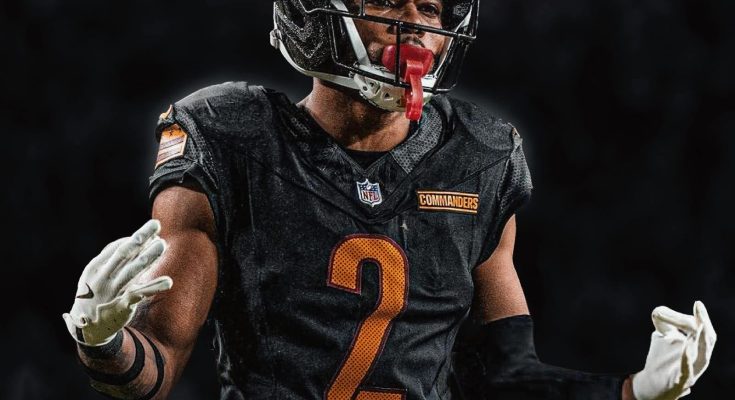Marshon Lattimore, one of the most respected cornerbacks in the NFL, endured a difficult outing in Week 7, reflected clearly in his Pro Football Focus (PFF) coverage grade of 29.2 — one of the lowest marks of his career. The Washington Commanders, who acquired the four-time Pro Bowler to bolster their secondary and bring stability to a defense that had long struggled against elite wideouts, saw their star defender face two of the league’s most dynamic receivers: George Pickens and CeeDee Lamb. Both receivers made their presence felt, testing Lattimore throughout the game and exposing weaknesses that rarely show up in his performances.
For Lattimore, the numbers tell part of the story — Pickens finished with four receptions for 82 yards, while Lamb carved up the secondary for five catches, 110 yards, and a touchdown. But beyond the stats, the tape revealed a game where Lattimore appeared out of rhythm, hesitant, and sometimes a step behind. For a cornerback whose career has been defined by physicality, anticipation, and elite mirror technique, this performance felt uncharacteristic. However, the context matters. The Commanders’ defensive scheme in Week 7 forced Lattimore into challenging matchups without consistent safety help, and both Pickens and Lamb exploited every opening.
When Washington traded for Lattimore during the offseason, the expectation was that he would immediately elevate the team’s pass defense and bring a veteran’s discipline to a young, developing unit. Through the first few weeks, that vision seemed to be materializing. Lattimore’s coverage against top receivers like A.J. Brown and Terry McLaurin earlier in the season had been solid, often limiting big plays and keeping Washington competitive in key downs. But Week 7 offered a harsh reminder that even elite defenders can have off days, especially when facing versatile route runners like Lamb and physically dominant threats like Pickens.
Lamb’s production came largely from creative route combinations and pre-snap motion designed to create confusion in the secondary. The Cowboys often shifted Lamb across formations, forcing Lattimore to play in different leverage positions, sometimes in the slot and other times on the boundary. This kind of versatility made it difficult for the Commanders to adjust effectively. Lamb’s touchdown came on a beautifully executed out-and-up route, where he sold the underneath cut and turned Lattimore around before tracking the ball over his shoulder. The precision of Dak Prescott’s throw and Lamb’s timing left no margin for recovery, but the breakdown in technique from Lattimore was noticeable — his hips opened too early, and his eyes momentarily left the receiver.
On the other side, George Pickens’ success against Lattimore was more about physicality. Pickens thrives on contested catches, and his ability to use his frame to box out defenders has made him one of the most dangerous young receivers in football. Lattimore tried to counter with his trademark aggressive press coverage, but Pickens repeatedly found ways to create just enough separation downfield. His 82 yards included several intermediate completions along the sideline, where his strong hands and body control allowed him to outmuscle the veteran corner. The Steelers clearly identified Lattimore as a one-on-one target in situations where the safety rotated to the opposite side, and Pickens took advantage.
PFF’s grading system takes into account multiple aspects of coverage, including positioning, separation allowed, and tackling efficiency after the catch. Lattimore’s 29.2 grade wasn’t just about yardage given up — it was also about missed opportunities to disrupt routes and make key plays on the ball. He failed to record a pass breakup, and on multiple occasions, he was slow to react to the ball in flight. For someone known for his ball-hawking instincts and ability to anticipate route stems, this game stood out as an anomaly. Still, the NFL is a league of matchups, and the difference between an elite performance and a poor one can sometimes hinge on a single step or moment of hesitation.
One of the challenges for Lattimore in Washington’s system has been adjusting to the Commanders’ blend of man and zone principles under defensive coordinator Joe Whitt Jr. Lattimore’s best years in New Orleans came when he was allowed to shadow the opponent’s top receiver and play tight man coverage throughout the game. In Washington, however, the scheme occasionally rotates coverages post-snap, requiring corners to pass off routes and trust the safeties behind them. Against offenses like Dallas and Pittsburgh, which excel at manipulating defensive eyes and spacing, that can be a recipe for confusion. On Sunday, those rotations often left Lattimore in unfavorable positions, either matched against slot receivers in open space or responsible for deep zones without help over the top.
Despite the disappointing grade, it’s worth remembering that Lattimore has bounced back from adversity before. In 2021, he had several tough outings early in the season before closing strong and reestablishing himself as one of the league’s premier corners. His ability to learn from film and correct technical lapses has been one of his defining traits since entering the league in 2017. He will surely study his matchups against Pickens and Lamb carefully, focusing on where he lost leverage and how to better anticipate their route tendencies in future games.
What makes Lattimore’s poor Week 7 grade so surprising is how dominant he has been throughout his career against elite talent. He’s built a reputation as a “big-game” corner — someone who raises his level when facing All-Pro caliber receivers. Names like Mike Evans, Justin Jefferson, and Deebo Samuel have all struggled at times when lined up across from him. His physical press technique, hand usage, and closing speed have made him a nightmare for wideouts who rely on rhythm and precision. Yet against Pickens and Lamb, the small details that usually separate Lattimore from the pack — footwork, discipline, and timing — seemed just slightly off. Those subtle breakdowns add up quickly against top-tier opponents.
The Commanders’ coaching staff also deserves some scrutiny for their defensive approach in this game. The lack of consistent safety support, particularly against Lamb, made it easier for Dallas to exploit mismatches. Washington blitzed more frequently than usual, leaving the secondary in man coverage situations against some of the best route runners in the league. While aggression can pay off, it also exposes corners to high-risk plays when pressure doesn’t arrive in time. In this case, both Prescott and Kenny Pickett were able to get the ball out quickly, neutralizing Washington’s pass rush and forcing Lattimore into reaction mode.
Another element that contributed to Lattimore’s struggles may have been fatigue. The Commanders’ defense was on the field for long stretches, and the physical toll of repeatedly tracking two receivers with contrasting styles can’t be underestimated. Pickens demands strength and physical endurance on the boundary, while Lamb tests agility and change of direction in space. Balancing both assignments throughout the afternoon is a challenge even for elite defenders. Lattimore’s effort never wavered — he remained competitive on every snap — but the wear and tear showed as the game progressed.
The 29.2 coverage grade is certainly a blemish, but it doesn’t redefine who Marshon Lattimore is. Great cornerbacks occasionally have poor statistical games, especially when they are asked to shoulder a heavy workload against top-tier receivers. What separates the best from the rest is how they respond. For Lattimore, this performance might serve as fuel heading into the next stretch of games. He’s known for his pride and competitiveness, traits that often drive him to deliver bounce-back performances after adversity. His teammates have already expressed confidence that this game was an outlier rather than a trend.
Washington, meanwhile, will need to reassess its coverage strategies. With Lattimore, Kendall Fuller, and rookie defensive back Mike Sainristil, the Commanders have the personnel to be one of the better secondaries in the NFC. However, cohesion and communication remain a work in progress. If the coaching staff can better tailor their game plans to Lattimore’s strengths — primarily press-man coverage and shadow assignments — his performance should rebound quickly. The Commanders brought him in to lock down opposing WR1s, not to play reactive zone defense. The more they trust him in isolation, the better he tends to perform.
It’s also important to acknowledge that PFF grades, while insightful, aren’t the final word on a player’s performance. They offer a quantitative measure, but they don’t always capture the full context — coverage busts by safeties, missed assignments by linebackers, or miscommunications in zone handoffs can all drag down a corner’s grade. Lattimore’s 29.2 reflects a tough day, but it also mirrors the collective struggles of Washington’s pass defense. When a secondary unit doesn’t move as one, even the best individual talents can look vulnerable.
Looking ahead, Lattimore’s next few games will reveal whether Week 7 was a fluke or the start of a concerning pattern. The Commanders’ upcoming schedule doesn’t get easier, with matchups against high-powered passing attacks that include the Eagles and 49ers. Both teams will undoubtedly study the tape from Week 7 and look for ways to replicate Dallas and Pittsburgh’s success. That said, betting against Lattimore’s ability to adjust would be unwise. His film study habits, combined with his athletic ability and pride in his craft, make him one of the most capable corners in the league when it comes to self-correction.
In many ways, this game was a reminder of how demanding the cornerback position is in today’s NFL. The rules favor offenses, quarterbacks are more accurate than ever, and receivers are faster, stronger, and more technically polished. Even the best defenders are walking a tightrope on every snap. One misread, one false step, or one mistimed hand placement can result in a highlight-reel play for the opponent. Lattimore’s 29.2 grade, while disappointing, is part of that reality. It underscores how razor-thin the margins are at the professional level and how even the smallest lapses can be magnified against elite competition.
Ultimately, Week 7 will likely serve as a humbling but valuable lesson for Marshon Lattimore and the Commanders. For a team still trying to forge its identity under a new system, games like this reveal the areas that need refinement — communication, coverage discipline, and trust between corners and safeties. For Lattimore, it’s another challenge in a career built on resilience. He’s been doubted before, he’s been beaten before, and every time, he’s come back sharper. That’s what great players do. The Commanders brought him in to lead by example, and his response in the coming weeks will say far more about his value than any single grade ever could.


